Colorado Springs, Colorado, Hgh State Clinic, Hgh Injections, Hrt Doctors
Colorado Springs, Colorado Blood Testing Facilities
 Represents a LabCorp blood testing facility
Represents a LabCorp blood testing facility Represents a Quest Diagnostics blood testing facility
Represents a Quest Diagnostics blood testing facility
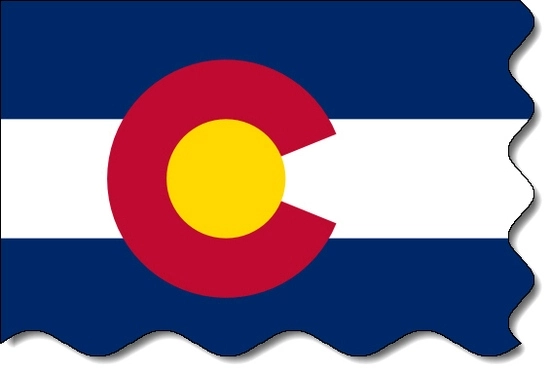
Nearby Labcorp Blood Testing facilities:
- Labcorp Center Distance: 1 m, 3225 International Cir Ste 200, Colorado Springs, El Paso County, CO, 80910
- Labcorp Center Distance: 5 m, 5664 N Union Blvd, Colorado Springs, El Paso County, CO, 80918
- Labcorp Center Distance: 9 m, 8540 Scarborough Dr Ste 170, Colorado Springs, El Paso County, CO, 80920
- Labcorp Center Distance: 35 m, 729 East Spaulding Ave, Pueblo West, Pueblo County, CO, 81007
- Labcorp Center Distance: 37 m, 3676 Parker Blvd Ste 200, Pueblo, Pueblo County, CO, 81008
- Labcorp Center Distance: 39 m, 1619 Greenwood St. 102, Pueblo, Pueblo County, CO, 81003
- Labcorp Center Distance: 40 m, 14 E Allen St, Castle Rock, Douglas County, CO, 80108
- Labcorp Center Distance: 46 m, 19641 East Parker Square Dr I, Parker, Douglas County, CO, 80134
- Labcorp Center Distance: 48 m, 10103 Ridgegate Pkwy Ste 123, Lone Tree, Douglas County, CO, 80124
- Labcorp Center Distance: 50 m, 9141 S Broadway, Highlands Ranch, Douglas County, CO, 80129
- Labcorp Center Distance: 51 m, 206 W County Line Rd Ste 150, Highlands Ranch, Douglas County, CO, 80129
- Labcorp Center Distance: 52 m, 24250 E Smoky Hill Rd, Aurora, Arapahoe County, CO, 80016
- Labcorp Center Distance: 54 m, 8200 E Belleview Ave Ste 234C, Greenwood Village, Arapahoe County, CO, 80111
- Labcorp Center Distance: 55 m, 6169 S Balsam Way Ste 312, Littleton, Jefferson County, CO, 80123
- Labcorp Center Distance: 56 m, 18461 E Hampden Ave, Aurora, Arapahoe County, CO, 80013
- Labcorp Center Distance: 57 m, 601 East Hampden Ave Ste 340, Englewood, Arapahoe County, CO, 80113
- Labcorp Center Distance: 58 m, 1550 S Potomac Ste 325, Aurora, Arapahoe County, CO, 80012
- Labcorp Center Distance: 62 m, 8015 W Alameda Ave Ste 30, Lakewood, Jefferson County, CO, 80226
- Labcorp Center Distance: 64 m, 1805 Kipling St 111, Lakewood, Jefferson County, CO, 80215
- Labcorp Center Distance: 65 m, 3555 Lutheran Pkwy Ste 190, Wheat Ridge, Jefferson County, CO, 80033
- Labcorp Center Distance: 74 m, 4001 E 120Th Ave, Thornton, Adams County, CO, 80233
- Labcorp Center Distance: 75 m, 12213 Pecos St 600, Westminster, Adams County, CO, 80234
- Labcorp Center Distance: 76 m, 899 Us Highway 287 Ste 500, Broomfield, Broomfield County, CO, 80020
- Labcorp Center Distance: 82 m, 5377 Manhattan Circle 100, Boulder, Boulder County, CO, 80303
Nearby Quest Blood Testing facilities:
- Quest Center Distance: 3 m, 2749 Janitell Road, Colorado Springs, El Paso County, CO, 80906-4102
- Quest Center Distance: 5 m, 2890 N Powers Blvd, Colorado Springs, El Paso County, CO, 80922-2800
- Quest Center Distance: 6 m, 840 Village Center Dr, Colorado Springs, El Paso County, CO, 80919-3603
- Quest Center Distance: 8 m, 6140 Tutt Blvd, Colorado Springs, El Paso County, CO, 80923-3574
- Quest Center Distance: 10 m, 6925 Mesa Ridge Pkwy, Fountain, El Paso County, CO, 80817-1504
- Quest Center Distance: 15 m, 1101 E Us Highway 24, Woodland Park, Teller County, CO, 80863-2121
- Quest Center Distance: 17 m, 624 W Highway 105, Monument, El Paso County, CO, 80132-9169
- Quest Center Distance: 34 m, 1414 Main St, Canon City, Fremont County, CO, 81212-3906
- Quest Center Distance: 35 m, 1017 N Market Plz, Pueblo, Pueblo County, CO, 81007-1530
- Quest Center Distance: 41 m, 1231 S Prairie Ave, Pueblo, Pueblo County, CO, 81005-2022
- Quest Center Distance: 47 m, 11051 S Parker Rd, Parker, Douglas County, CO, 80134-7441
- Quest Center Distance: 54 m, 6179 S Balsam Way, Littleton, Jefferson County, CO, 80123-3095
- Quest Center Distance: 57 m, 201 E Jefferson Ave, Englewood, Arapahoe County, CO, 80113-3726
- Quest Center Distance: 59 m, 1411 S Potomac St, Aurora, Arapahoe County, CO, 80012-4542
- Quest Center Distance: 60 m, 695 S Broadway, Denver, Denver County, CO, 80209-4003
- Quest Center Distance: 69 m, 7353 Federal Blvd, Westminster, Adams County, CO, 80030-4903
- Quest Center Distance: 75 m, 100 E 120Th Ave, Northglenn, Adams County, CO, 80233-5743
- Quest Center Distance: 77 m, 1601 Coalton Rd, Superior, Boulder County, CO, 80027-4610
- Quest Center Distance: 79 m, 1605 Bridge Street, Brighton, Adams County, CO, 80601-1931
- Quest Center Distance: 84 m, 2798 Arapahoe Ave, Boulder, Boulder County, CO, 80302-6714
- Quest Center Distance: 88 m, 8134 Colorado Blvd, Firestone, Weld County, CO, 80504-6400
Colorado Springs Hormone Replacement Therapy Services
Have you ever thought about talking to a doctor about your Hormone Balance? The Conscious Evolution Institute is a certified Online Hormone Clinic which dedicates itself to providing quality Hormone Therapy Products and Services to the citizens of the Colorado Springs area. We have mastered the art of providing quality services remotely, which allows us to provide our HRT Treatments at the cheapest prices, while also offering streamlined and quality care.
When you make the call to the Conscious Evolution Institute, we will arrange for you to meet an affiliate health professional in the Colorado Springs area that will perform a physical and take a simple blood sample which will be thoroughly analyzed in order to provide a vivid and clear state of yout total health, including various aspects which offer insight into your Hormone Balance. We work with Online Hormone Pharmacies that specialize in treatments like Testosterone and HGH Therapy, which have changed millions of lives across the country. If you are interested in finding out whether Hormone Optimization can improve your life, contact us by phone or fill out the form on this page for a no-cost, no-obligation consultation!
Colorado Springs Low-T Therapy for Testosterone Deficiency
Andropause is a medical condition, similar to Menopause, in which men start to produce less and less Testosterone as they age, which tends to become symptomatic during midlife. Testosterone Deficiency has major implications for health and wellness—not only sexual health, but physical and mental health as well. Luckily, Age-Associated Low-T can be easily and effectively treated through the use of Bio-Identical Testosterone Products such as Testosterone Transdermal Patches, Testosterone Topical Gels, and Testosterone Intramuscular Injections.
Testosterone Deficiency is associated with a wide swath of symptoms, such as unexplained weight gain, increased frailty and fading strength, suppressed sexual function, cholesterol imbalance, and hypertension. With Low-T Therapy, men have experienced truly life changing results from treatment, and the Conscious Evolution Institute can help you get the Bio-Identical Testosterone Therapy Treatments that you need to restore your sexual fire, your physical vitality, and your psychological balance.
Colorado Springs Growth Hormone Injection Therapy for HGH Deficiency
Human Growth Hormone Deficiency is a serious and underdiagnosed medical affliction that becomes more and more likely with every year that a man or woman grows older. HGH is one of the most important hormones when it comes to sustaining and maintaining health with age. Human Growth Hormone Deficiency literally slows the body down, preventing it from taking care of its daily needs, leading to a cascade of physiological failures which lead to premature aging.
HGH Injection Therapy can mitigate the effects of Growth Hormone Decline, helping patients grow older without being burdened by the various symptoms of such deficiency. The symptoms of HGH Deficiency are many, and affect nearly all major systems of the body. These symptoms include increased body fat, loss of muscle volume and strength, depression, suppressed immune system, increased incidence of fine lines and wrinkles, and poor cholesterol levels. Our specialized Injectable Growth Hormone Regimen can get your Hormone Levels back in balance and potentially vastly improve your quality of life, especially when combined with a smart nutrition and exercise regimen.
Colorado Springs Sermorelin Injection Therapy for HGH Optimization
Sermorelin is another revolutionary option available to patients suffering from Human Growth Hormone Deficiency. Sermorelin is a Bio-Identical Recombinant Hormone Therapy which stimulates the human pituitary to produce its own natural HGH. For a large portion of patients, Sermorelin may even be the superior option for treatment. Most patients with Adult HGH Deficiency have fully functional pituitary glands, they just don't produce enough GH-RH.
Sermorelin has the same effect on the human body as GH-RH, and allows the body to control how it makes Human Growth Hormone. Many patients even qualify for Sermorelin Therapy even if HGH Injections are not available to them, and with the cheaper price of Sermorelin as opposed to Human Growth Hormone, it's no wonder so many patients, as well as their doctors, prefer Sermorelin Acetate.
Colorado Springs HCG Diet Injection Therapy
Another fantastic treatment that we offer at our clinic is Injectable HCG Weight Loss Therapy. For patients that have tried other diets without reliable success, HCG Injection Treatments offers patients the chance to experience rapid weight loss of up to fourteen pounds every two weeks. When combined with Caloric Restriction, HCG leads to significant weight loss, while also encouraging the body to protect muscle mass and burn fat, leading to a more ideal body composition. Beyond this, HCG also weakens hunger signals from the stomach to the brain, making it easier to psychologically handle such a low-calorie diet. If you'd like to find out if Bio-Identical HCG Therapy is right for you, call us and talk to one of our friendly medical specialists!
Colorado Springs, Colorado Information
The city of Colorado Springs is located in central Colorado, and is the 2nd most highly populated city in the state. Colorado Springs is primarily known for two things: The large military presence in the city and the strong religious tenor that echoes through the city. Colorado Springs is home to one of the largest evangelical Christian populations in the United States, and evangelicals are moving to the area at a rapid pace. Colorado Springs is home to the United States Air Force Academy, whose mascot is the Falcon. Other military bases in Colorado Springs include Cheyenne Mountain Air Station, NORAD, Schriever Air Force Base, Peterson Air Force Base, and Fort Carson. Colorado Springs is considered one of the top places to live and raise a family in the United States.
Aside from military, the Colorado Springs economy is also driven by tourism and technology. Colorado Springs is located along the Southern Rocky Mountains, and is also very close to Pike's Peak. The area around Colorado Springs is notable for its beauty, and the pristine nature surrounding the city brings people from all over the country to experience the scenery and the outdoor activities available. Tech companies located in the Colorado Springs area include Cypress Semiconductor, Atmel, LSI Corporation, and Verizon Business.
All About Colorado Springs, Colorado Geographic Area
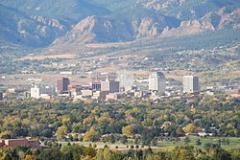
Colorado Springs is a Home Rule Municipality that is the county seat and most populous city of El Paso County, Colorado, United States. Colorado Springs is located in the southern portion of the state. It is situated on Fountain Creek and is located 65 miles (105 km) south of the Colorado State Capitol in Denver. At 6,035 feet (1839 m) the city stands over one mile (1.6 km) above sea level, though some areas of the city are significantly higher and lower. Colorado Springs is situated near the base of one of the most famous American mountains, Pikes Peak, in the eastern edge of the Southern Rocky Mountains.
With a population of 416,427 as of the 2010 Census, it is the second most populous city in the state of Colorado, behind Denver, and the 41st most populous city in the United States, while the Colorado Springs Metropolitan Statistical Area had an estimated population of 645,613 in 2010. The city covers 194.7 square miles (504 km2), making it Colorado's largest city in area. Colorado Springs was selected as the No. 1 Best Big City in "Best Places to Live" by Money magazine in 2006, and placed number one in Outside's 2009 list of America's Best Cities.
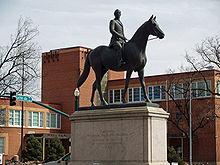
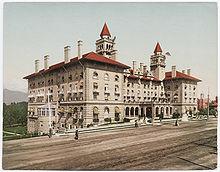
William Jackson Palmer, a Civil War General (brevet) and Medal of Honor recipient, came to the Colorado Territory as a surveyor with the Kansas Pacific Railroad. He explored the area south of Denver searching for possible railroad routes for the Kansas Pacific to strategically occupy. Palmer favorably viewed the valley in the shadow of Pikes Peak as an ideal town site. Since he could not persuade the Kansas Pacific to follow the Arkansas River to Pueblo and from there north to Denver, Palmer secured legislation and funding to build the Denver & Rio Grande Railroad south from Denver with the declared intention of reaching Mexico City, Mexico. Palmer founded Colorado Springs on July 31, 1871, as the first destination served by his railroad. He had the intention of creating a high-quality resort community, and the infant town was soon nicknamed "Little London" because of the many English tourists and settlers who came, owing partly to Palmer's financial connections in England who provided the capital for his railroad, and partly to his associate Dr. William Bell who actively recruited both investors and settlers. The stunning mountain view from anywhere in the valley as well as the nearby Garden of the Gods made the city's location a natural choice.
Within two years, his flagship resort the Antlers Hotel opened, welcoming US and international travelers as well as health-savvy individuals seeking the high altitude, sunshine, and dry climate, and Palmer's visions of a thriving, quality resort town were coming true. Palmer's Denver & Rio Grande Railroad became a critical regional railroad, faithfully serving the city and propelling the railroad south toward Pueblo. He maintained his presence in the city's early days by making many grants or sales of land to civic institutions. Palmer and his wife saw Colorado Springs develop into one of the most popular travel destinations in the late 19th century United States.
The town of Palmer Lake, the Palmer Divide, and other more minor features are named after him, and a bronze sculpture of Palmer on a horse is prominently displayed downtown in front of Palmer High School, at the center of a busy intersection. To many residents who lived in Colorado Springs in the years since, Palmer became known as "the man on the iron horse", a fitting appellation because of his long association with the Rio Grande Railroad.
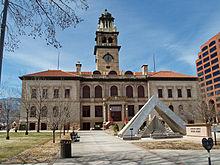
Colorado Springs' present downtown location, where General Palmer first founded the city, was partly due to Palmer's dislike of nearby rough-and-ready Colorado City (now called Old Colorado City, and not to be confused with present-day Colorado City) and its many saloons. Palmer ensured his new planned city stayed alcohol free by buying a huge tract of land to the east of Colorado City. Legally, Colorado Springs stayed dry until the end of Prohibition in 1933, but practically, alcohol was readily available. Conveniently located druggists advertised whiskey, ale, stout and beer for "medicinal purposes."
In its earliest days of 1859 ae1860, Colorado City was a major hub for sending mining supplies to South Park, where a major strike in the Pike's Peak Gold Rush was found. After the Cripple Creek gold discovery in 1891, ore mills in Colorado City processed much of the gold ore at the Golden Cycle Mill using Palmer's railroads. The affluent, who made money from the gold rush and industry, did not stay in Colorado City but built their large houses in the undeveloped downtown area of Colorado Springs (i.e. Wood Ave). Early pictures show several large stone buildings like Colorado College, St. Mary's Church, the first Antlers Hotel, the library, and the county courthouse (pictured at right) sitting in large empty plains. This is unique during this period, to anticipate a city's civic infrastructure in stone with wide streets laid out before there was a population to justify the expense.
Colorado City remained the county seat of El Paso County until 1873, when the courthouse moved to Colorado Springs. Colorado City was the location of a 1903 labor strike that spread to Cripple Creek and eventually led to the Colorado Labor Wars.
In 1891, Winfield Scott Stratton discovered and developed one of the richest gold mines on earth in the nearby Cripple Creek and Victor area, and was perhaps the most generous early contributor to those communities and to Colorado Springs.
After he made his fortune he declined to build a mansion as the other gold rush millionaires were doing; instead, in later years, he lived in a house in Colorado Springs he had built when he was a carpenter in pre-gold days.
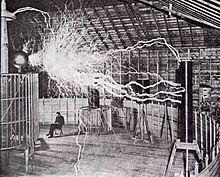
In Colorado Springs, he funded the Myron Stratton Home for housing itinerant children and the elderly, donated land for City Hall, the Post Office, the Courthouse (which now houses the Pioneer Museum), and a park; he also greatly expanded the city's trolley car system and built the Mining Exchange building, and gave to all three communities in many other ways, great and small.
As Stratton's generosity became known, he was also approached by many people looking for money, and he became reclusive and eccentric in his later years.
Spencer Penrose also made his mark on Colorado Springs in its early years aethough not until two decades after its founding. Penrose started as a ladies-man and an adventurer. After making a fortune in the gold fields of nearby Cripple Creek in the 1890s, he married Julie Villiers Lewis McMillan, and settled down.
Penrose used his wealth to invest in other national mineral concerns and financed construction of the Broadmoor Hotel, the Cheyenne Mountain Zoo, the Will Rogers Shrine of the Sun, the Pikes Peak Highway, what is now known as Penrose-St Francis Health Services, and established the El Pomar Foundation, which still oversees many of his contributions in Colorado Springs today.
The flow of gold and silver ebbed as the decades passed, and Colorado City's economic fortunes faded with it; the miners and those who processed the ore left or retired. Because of the healthy natural scenic beauty, mineral waters, and extremely dry climate, Colorado Springs became a tourist attraction and popular recuperation destination for tuberculosis patients. The healthy waters in Colorado Springs contained so much natural fluoride that some peoples ao teeth developed Colorado Stain. In 1909, Dr. Frederick McKay of Colorado Springs discovered the Colorado Stain connection and that a little fluoride added to water would prevent cavities, according to the permanent health exhibit at the Pioneers Museum. On June 14, 1950 Colorado Springs annexed Roswell which was founded in 1888 by coal miners and became a neighborhood. Other locations such as Austin Bluffs, Broadmoor, Woodman Valley, Pikeview, Papeton, Knob Hill, Ivywild, Stratton Meadows, Stratmoor, Elsmare, Cimarron Hills, Kelker, Stratmoor Hills, La Foret, Skinners, and Colorado City (now called Old Colorado City) became part of Colorado Springs. Old Colorado City is located on the west side of Colorado Springs and is a historic district and on the National Register of Historic Places. Its old Victorian brick buildings and main street currently offer several tourist, boutique, and antique shops.
Colorado Springs saw its first military bases in 1942 shortly after Pearl Harbor was attacked. For several years the city had been trying to attract a military installation to boost its flagging economy. In 1941, the city purchased 25,000 acres (100 km2) of what is now Fort Carson to try to lure a prospective Army installation. The U.S. Army established Camp Carson near the southern borders of the city in order to train and house troops in preparation for World War II. It was also during this time that the Army began using Colorado Springs Municipal Airport. It was renamed Peterson Field and used as a training base for heavy bombers (the airport and base still share parts of the flightline). Camp Hale was also established in 1942 in nearby west-central Colorado to provide winter and mountain warfare training during World War II (WWII) for training in skiing, rock climbing, and cold weather survival skills.
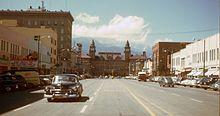
As for Camp Carson, the Army expanded it in a venture that increased growth in Colorado Springs and provided a significant area of industry for the city. Camp Carson was named for the Army scout General Christopher "Kit" Carson, who explored the vast western frontier during the 19th century. After World War II the military stepped away from the Springs, Camp Carson was declining and the military was activating and deactivating Peterson Field irregularly. That all changed when the Korean War erupted. Camp Carson, which had declined to only 600 soldiers, was revitalized along with many other parts of the Springs. In 1951, the United States Air Defense Command moved to Colorado Springs and opened Ent Air Force Base (named for Major General Uzal Girard Ent, commander of the Ninth Air Force during World War II).
After the Korean War, Peterson Field was renamed Peterson Air Force Base and was permanently activated. In 1954 Camp Carson became Fort Carson, Colorado Springs' first Army post. Later that same year, President Dwight D. Eisenhower selected Colorado Springs, out of 300 other sites around the nation, to be the site of the United States Air Force Academy. A new and growing Army post, an Air Force Base, and the Air Force's military academy together jump-started Colorado Springs' growth.
The military boom continued and in 1963, NORAD's main facility was built in Cheyenne Mountain. This placed NORAD directly next to Colorado Springs and permanently secured the city's military presence. During the Cold War the city greatly expanded due to increased revenue from various industries and the prevailing military presence in the city. In the mid 1970s, Ent Air Force Base was shut down and later converted into the United States Olympic Training Center. Military presence was further increased in 1983 with the founding of Falcon Air Force Base (later changed to Schriever Air Force Base), a base primarily tasked with missile defense and satellite control. Fort Carson and Peterson are still growing and continue to contribute to the city's growth. Air Force Space Command is located on Peterson AFB.
The Waldo Canyon fire, which started on June 23, 2012, sparked three miles west of Colorado Springs. Three days later, on June 26, the fire exploded eastward toward and into the city, engulfing the neighborhoods of Mountain Shadows and Peregrine. Evacuations peaked on June 27 at 32,000 residents. After an investigation, Colorado Springs Fire Department and United States Forest Service announced that 346 homes were destroyed and two people died during the course of the fire in the Mountain Shadows neighborhood. On the night of June 26, the Waldo Canyon Fire became the most destructive fire in Colorado history, passing the High Park Fire of 2012. Upon reaching 100% containment on July 10, 2012, the total number of acres burned totaled 18,247. The cause of the fire remains under investigation. As of September 25, 2012, the city offered $100,000 to any lead of the cause of the fire.
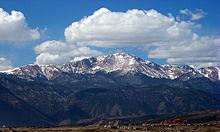
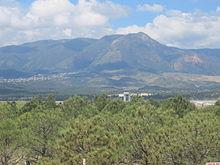
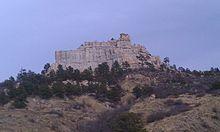
According to the United States Census Bureau, the city has a total area of 186.1 square miles (482.1 km ²), of which 185.7 square miles (481.1 km ²) is land and 0.4 square mile (1.0 km ²) (0.21%) is water.
Colorado Springs features a semi-arid climate (Koppen BSk). The city receives approximately 16.2 inches (41 cm) of annual precipitation, which includes rain and snow. The average snowfall is 42.7 inches (108 cm). Due to unusually low precipitation for several years after flooding in 1999, Colorado Springs enacted lawn water restrictions in 2002. These were lifted in 2005.
January averages 28.1 °F ( na2.2 °C), and daytime highs range anywhere from single digits all the way up to low 60s. Summers are typically very warm with occasional heat waves and generally arid with episodic heavy rainfalls and large hail, with a July average of 69.6 °F (20.9 °C) and highs reaching 90 °F (32 °C) on 16 days per annum. The normal high temperatures during the day are in the mid-80s into the low 90s, with cooler days in the low 80s and upper 70s. Also very hot days can reach the mid to upper 90s relatively often. The summers in Colorado Springs are generally hot and dry, but afternoon thunderstorms are common especially in July and August when the city receives the majority of its annual rainfall, due to the North American Monsoon.
Colorado Springs is just east of the Southern Rocky Mountains, which protects the city from alpine weather. The city is made up of the mountains to the west, the mountain divide to the north, high plains further east, and desert land to the south once you leave Fountain and approach Pueblo. The city has abundant sunshine throughout the year, averaging over 300 days of sun per year.
The winters in Colorado Springs range from mild to occasional bitter cold at certain points, with winter snow storms possible from September until May. Most snowfalls melt often, due to the high altitude and abundant sunshine throughout the year. However, the mountains just west of the city can receive very large amounts of snow during the winter.
The hottest temperature ever recorded in Colorado Springs was 101 °F (38 °C) on June 26, 2012, and the coldest temperature ever recorded was na32 °F ( na36 °C) on January 20, 1883. Although the coldest average monthly high temperature of the year in Colorado Springs has historically been January, in recent years December has had a colder average monthly high temperature.
Colorado Springs is also one of the most active lightning strike areas in the United States. This natural phenomenon led Nikola Tesla to select Colorado Springs as the preferred location to build his lab and study electricity.
As of the 2010 census, the population of Colorado Springs was 416,427 (47th most populous U.S. city), and the population of the Colorado Springs Metropolitan Statistical Area was 645,613 in 2010 (84th most populous MSA), and the population of the Front Range Urban Corridor in Colorado was an estimated 4,166,855.
As of the April 2010 census:
As of the census of 2000 (limited only to the city limits and not including the very diverse Fort Carson area which many view as being a part of the Colorado Springs metropolitan area), there were 360,890 people, 141,516 households, and 93,117 families residing in the city. The population density was 1,942.9 people per square mile (750.2/km ²). There were 148,690 housing units at an average density of 800.5 per square mile (309.1/km ²). The racial makeup of the city was 80.66% White, 6.56% African American, 0.88% Native American, 2.82% Asian, 0.21% Pacific Islander, 5.01% from other races, and 3.85% from two or more races. 12.01% of the population were Hispanic or Latino of any race.
There were 141,516 households out of which 34.0% had children under the age of 18 living with them, 51.5% were married couples living together, 10.6% had a female householder with no husband present, and 34.2% were non-families. 27.0% of all households were made up of individuals and 6.9% had someone living alone who was 65 years of age or older. The average household size was 2.50 and the average family size was 3.06.
In the city the population was spread out with 26.5% under the age of 18, 10.3% from 18 to 24, 32.8% from 25 to 44, 20.8% from 45 to 64, and 9.6% who were 65 years of age or older. The median age was 34 years. For every 100 females there were 97.8 males. For every 100 females age 18 and over, there were 95.2 males. (Note: City statistics do not include the demographic influence of five local military bases).
The median income for a household in the city was $45,081, and the median income for a family was $53,478. Males had a median income of $36,786 versus $26,427 for females. The per capita income for the city was $22,496. About 6.1% of families and 8.7% of the population were below the poverty line, including 10.8% of those under age 18 and 7.2% of those age 65 or over.
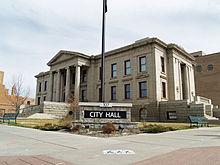
On November 2, 2010 Colorado Springs voters adopted a strong mayor-council form of government. The City of Colorado Springs transitioned to the new system of government in 2011. Under the strong mayor-council system of government, the mayor is the chief executive and the city council is the legislative branch. The mayor is a full-time elected position and not a member of the city council. The city council has nine members total, four of which represent one of four equally-populated districts each. The remaining five members are elected "at-large". The mayor has veto authority, with the city council having the ability to override a mayoral veto by a two-thirds majority vote (6 out of 9).
Colorado Springs' economy is driven primarily by the military, the high-tech industry, and tourism, in that order. The city is currently experiencing some growth mainly in the service sectors. The current unemployment rate, as of June 2012, in Colorado Springs is 9.8% compared to 8.2% for the State and the Nation.
The defense industry plays a major role in the Colorado Springs economy, with some of the city's largest employers coming from the sector. A large segment of this industry is dedicated to the development and operation of various projects for missile defense. With its close ties to defense, the aerospace industry has also influenced the Colorado Springs economy. Although some defense corporations have left or downsized city campuses, a slight growth trend is still recorded.
Significant defense corporations in the city include Boeing, General Dynamics, Harris Corporation, SAIC, ITT, L-3 Communications, Lockheed Martin, and Northrop Grumman.
A large percentage of Colorado Springs' economy is still based on manufacturing high tech and complex electronic equipment. The high tech sector in the Colorado Springs area has decreased its overall presence over the past six years (from around 21,000 down to around 8,000), with notable reductions in information technology and complex electronic equipment. Due to a slowing in tourism, the high tech sector still remains second to the military in terms of total revenue generated and employment. Current trends project the high tech employment ratio will continue to decrease in the near future.
High tech corporations with connections to the city include:
According to the City's 2009 Comprehensive Annual Financial Report, the top employers in the city are:
The United States Military plays a very important role in the city. Colorado Springs is home to both Army and Air Force bases. All these military installations border the city, to the north, south and east, excluding Schriever Air Force Base, which is located east of the city in El Paso County.
Fort Carson is the city's largest military base, and until mid-2006 was home to the 3d Armored Cavalry Regiment, which relocated to Fort Hood, Texas. In 2009, Fort Carson became the home station of the 4th Infantry Division, which nearly doubled the base's population. Fort Carson is host to various training grounds for infantry, armor, and aviation units (specifically the OH-58 Kiowa Warrior). Fort Carson is also the headquarters of the second and third battalions of the 10th Special Forces Group.
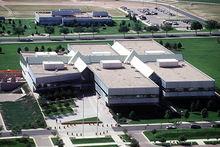
The Air Force has critical aspects of their service based at Colorado Springs which carry on missile defense operations and development. The Air Force bases a large section of the national missile defense operations here, with Peterson Air Force Base set to operate large sections of the program. Peterson AFB is currently the headquarters of the majority of Air Force Space Command and the operations half of Army Space and Missile Defense Command/Army Strategic Command (SMDC/ARSTRAT).
Peterson is also headquarters for the United States Northern Command (USNORTHCOM), one of the Unified Combatant Commands. USNORTHCOM directs all branches of the U.S. military operations in their area of responsibility which includes the continental United States, Alaska, Canada, and Mexico. In the event of national emergencies the President or Secretary of Defense can call upon USNORTHCOM for any required military assistance. Service members from every branch of the US Military are stationed at the command.
Schriever Air Force Base is home to the 50th Space Wing, which controls warning, navigational, communications and spy satellites. It is also the home of the Space Warfare Center and the home for the 576th Flight Test Squadron. It is the location of the Global Positioning System (GPS) master control station and GPS Operations Center and the US Naval Observatory Alternate Master Clock, used to synchronize GPS satellite time. Schriever is also developing parts of national missile defense and runs parts of the annual wargames used by the nation's military.
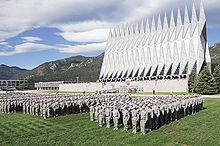
Just north of the city lie the vast grounds of the United States Air Force Academy, where cadets train to become officers in the Air Force. The campus is famous for its unique chapel and draws visitors year round. Most of the Air Force Academy's sports programs belong to the Mountain West Conference.
The North American Aerospace Defense Command (NORAD), a component of America's missile defense system, is located in Cheyenne Mountain Air Station. When it was built at the height of the Cold War, NORAD caused some anxiety for the residents in and around Colorado Springs, who believed the installation would be a primary target during a nuclear attack. Although NORAD still operates today, it is primarily tasked with the tracking of ICBMs, and the military has recently decided to place Cheyenne Mountain's NORAD/NORTHCOM operations on warm standby and move operations to nearby Peterson Air Force Base.
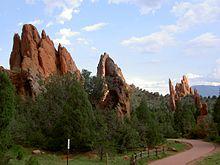
The city's location at the base of Pikes Peak and the Rocky Mountains makes it a popular tourism destination. Tourism is the third largest employer in the Pikes Peak region, accounting for more than 13,000 jobs. Nearly 5 million visitors come to the area annually, contributing $1.35 billion.
Colorado Springs has more than 55 attractions and activities in the area. The Colorado Springs Visitor Information Center located Downtown offers free area information to leisure and business travelers. The Cultural Office of the Pikes Peak Region (COPPeR), also located in downtown Colorado Springs, acts as an umbrella resource to support and advocate for the arts throughout the Pikes Peak Region. COPPeR operates a website called PeakRadar where organizations can post events happening around the city to boost community involvement and cultural awareness.
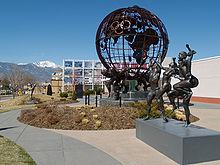
Colorado Springs is home to the United States Olympic Training Center and the headquarters of the United States Olympic Committee. In addition, a number of United States national federations for individual Olympic sports have their headquarters in Colorado Springs, including:
The city has a particularly long association with the sport of figure skating, having hosted the U.S. Figure Skating Championships 6 times and the World Figure Skating Championships 5 times. It is home to the World Figure Skating Museum and Hall of Fame and the Broadmoor Skating Club, a notable training center for the sport. In recent years, the World Arena has hosted skating events such as Skate America and the Four Continents Figure Skating Championships.
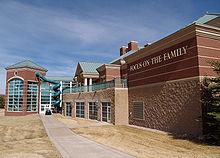
Although houses of worship of almost every major world religion can be found in the city, Colorado Springs has in particular attracted a large influx of Evangelical Christians and Christian organizations in recent years. At one time Colorado Springs was counted to be the national headquarters for 81 different religious organizations, earning the city the tongue-in-cheek nickname "the Evangelical Vatican" and "The Christian Mecca". Religious groups with regional or international headquarters in Colorado Springs include: the Association of Christian Schools International, the Christian and Missionary Alliance, Compassion International, Every Home for Christ, Focus on the Family, HCJB, the International Bible Society, The Navigators, the Roman Catholic Diocese of Colorado Springs, WAY-FM Media Group, Andrew Wommack Ministries, and Young Life.
Today, Colorado Springs has many features of a modern urban area, such as parks, bike trails, and urban open-area spaces. However, it is not exempt from problems that typically plague cities that experience tremendous growth like overcrowded roads and highways, crime, sprawl, and government budget issues. Many of the problems are indirectly or directly caused by the city's difficulty in coping with the large population growth experienced in the last 20 years and the annexing of the Banning Lewis Ranch area for 175,000 future residents.
Colorado Springs is served by a bus system called Mountain Metro (short for Mountain Metropolitan Transit). Mountain Metro also operates the Front Range Express (FREX) service, which connects Colorado Springs to Denver and several other metropolitan areas during weekdays. Although the transit system serves much of the city and its nearest suburbs, it lacks service to many important areas and has only limited hours of operation.
Colorado Springs is served by the Colorado Springs Municipal Airport. In the state of Colorado, only Denver International has more passenger traffic. The airport has experienced a higher recovery rate in the post-9/11 era than the rest of the country and is in the process of expanding its maintenance facilities, taxiways, and runways to accommodate future growth. In 2005 it served approximately two million passengers.
In 2004, the voters of Colorado Springs and El Paso County established the Pikes Peak Rural Transportation Authority and adopted a 1% sales tax dedicated to improving the region's transportation infrastructure. Together with state funding for the Colorado Springs Metro Interstate Expansion (COSMIX) (2007 completion) and the I-25 interchange with Highway 16 (2008 completion), significant progress has been made since 2003 in addressing the transportation needs of the area. Currently the City is trying to overcome a $23.3 million budget gap created by falling sales taxes and rising expenses.
Colorado Springs is primarily served by the interstate highways I-25 and U.S. Route 24.
In addition, there were plans to develop a "Front Range Toll Road", a privately owned turnpike, which would begin south of Pueblo and end around Fort Collins. This toll road would allow rail and truck traffic to avoid the more highly traveled parts of I-25 along the Front Range. Initially, the project had support but has since been highly contested because of the need to condemn the land of many private citizens, through the use of eminent domain, to make room for the corridor.
In order to combat congestion the Colorado Department of Transportation widened the Interstate 25 corridor throughout the city from four lanes (two in each direction) to six lanes. Ultimately, the plan is to make the interstate eight lanes through the city when funding becomes available. This plan is similar in nature to Denver's T-Rex expansion plan.
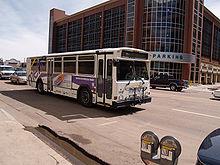
Several suggestions have been made to create a loop around the city though none have been implemented. The original plan to convert Powers Boulevard, a major eastside expressway, into a bypass for I-25 was abandoned, although some interchanges are overpasses and roads further east are being looked at. Easier access to the airport has also been suggested. Overall the new thoroughfares would include one (or two) loop freeways, a spur into the city connecting the main freeway and the loop, east-west expressway upgrades, and easier access to the Colorado Springs Airport.
Two grade separated interchanges were built in order to alleviate congestion at some of the city's worst intersections. Both the intersection at Powers and Woodmen and the intersection at Austin Bluffs and Union were converted into grade separated interchanges. A third interchange was built at the intersection of Woodmen Road and Academy Boulevard and was completed in the summer of 2011.
In early 2010, the city of Colorado Springs approved an expansion of the northernmost part of Powers Boulevard in order to create an Interstate 25 bypass commonly referred to as the Copper Ridge Expansion. The project developers also have hopes of increasing business at the future I-25 Powers Boulevard connection by building a 2.8 million sq. ft. shopping mall on the East side of the Powers exit. Developers hope to have the project finished by 2013, but have a deadline of 2018.
Colorado Springs is part of a consortium of cities trying to build the Front Range Commuter Rail.
A 2011 study by Walk Score ranked Colorado Springs 34th most walkable of fifty largest U.S. cities.
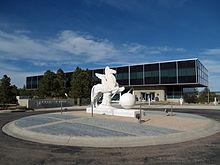
Universities, colleges and special schools include:
The city's public schools are divided into several districts:
Private schools:
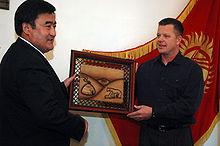
Sister cities of Colorado Springs include:
Colorado Springs' sister city organization began when Colorado Springs became partners with Fujiyoshida. The torii gate erected to commemorate the relationship stands at the corner of Bijou Street and Nevada Avenue, and is one of the city's most recognizable landmarks. The torii gate, crisscrossed bridge and shrine, located in the median between Platte and Bijou Streets in downtown Colorado Springs, were a gift to Colorado Springs, erected in 1966 by the Rotary Club of Colorado Springs to celebrate the friendship between the two communities. A plaque near the torii gate states that "the purpose of the sister city relationship is to promote understanding between the people of our two countries and cities". The Fujiyoshida Student exchange program has become an annual event.
To strengthen relations between the two cities, the Colorado Springs Youth Symphony regularly invites the Taiko drummers from the city to participate in a joint concert in the Pikes Peak Center. The orchestra played in Bankstown, Australia, in 2002 and again in June 2006 as part of their tours to Australia and New Zealand.
Also, in 2006 and 2010, the Bankstown TAP (Talent Advancement Program), performed with the Youth Symphony, and the Colorado Springs Children's Chorale, as a part of the annual In Harmony program.
A notable similarity between Colorado Springs and its sister cities are their geographic positions, three of the seven cities being located near the base of a major mountain or range.
Colorado Springs has been home to a number of famous artists, including actor Lon Chaney, Sr., members of the band OneRepublic, science fiction author Robert Heinlein, Peanuts creator Charles M. Schulz, conductor-composer Manoah Leide-Tedesco, and jazz guitarist Johnny Smith. Several athletes have also resided in Colorado Springs, including Baseball Hall of Fame member Goose Gossage, NBA Hall of Famer Rick Barry,2008 Olympic Gold Medalist Henry Cejudo and current UFC Mixed Martial Arts championship contender Donald 'Cowboy' Cerrone. Additionally, many well-known figure skaters, including Olympic champions Hayes Alan Jenkins, David Jenkins, and Peggy Fleming, have lived and trained in Colorado Springs during their competitive careers. Christopher Dean, 1984 Olympic gold medallist with partner Jayne Torvill, currently resides in Colorado Springs when not filming Dancing on Ice in England for six months of the year. Bill Roy, former Olympian and world champion skeet shooter, resides here. Award-winning author and lecturer Michael A. O'Donnell, Ph.D. resides here.
Colorado Springs has been the subject or setting for many books, movies and television shows, and is especially a frequent backdrop for political thrillers and military-themed stories because of its many military installations and vital importance to the United States' continental defense. Notable television series using the city as a setting include Dr. Quinn, Medicine Woman and the Stargate series Stargate SG-1 and the films WarGames and The Prestige.


Word Count: 6228






